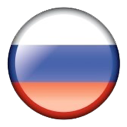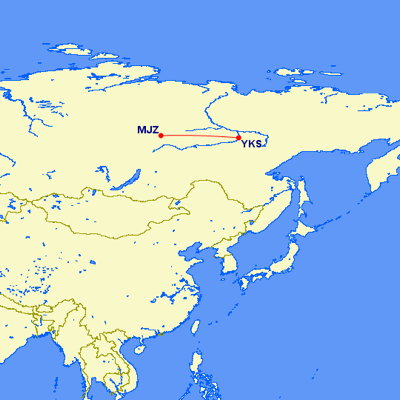From Houston to Sydney 2013

Russian Far East - 2014

The schedule for today was ‘end-loaded, in that nothing was scheduled in Yakutsk prior to leaving our hotel at 2:00pm to go to the airport to catch our flight to Mirny. Once 2:00pm arrived, however, the program was packed until almost 10:00pm in the evening (which, contrary to what I mistakenly wrote in yesterday’s diary entry, was actually about two and a half hours before sunset).
The weather in Yakutsk was hot and sunny – clear blue skies and temperatures between 28 and 30 degrees Celsius. I used my free time to complete two large circuits of walking. The first was to the north and west of the hotel, with the old church of St Nicholas being my destination.
The second walk was done after we had to check out (at midday) and before meeting at 2:00pm, and was probably more photogenic. This circuit took me to the north-east of the hotel where I came by chance upon a huge war memorial, almost North Korean in scale. Covering a prodigious amount of land beside the River Lena, the memorial was marked at the southern end by a large archway flanked by social realist figures and a preserved T-34 tank. Beyond the arch, a long avenue was lined on one side by memorials to the Hero Cities of the Great Patriotic War, and on the other side (beside the road), by a long line of large red stars. At the far northern end of the memorial, a tall obelisk stood above a large hammer and sickle, backed by the names of heroic soldiers.
The trip to the airport took only ten minutes, which meant we had quite a wait for our flight to Mirny. Eventually we boarded the oldest plane I have ever flown on (by age, not by year of manufacture), a 42 year old Antonov An-24 of Alrosa Airlines. It was manufactured in 1972 (the year I started my undergraduate studies at university), and was originally delivered to Aeroflot’s Mirny division back in the Soviet era when Aeroflot was (by far) the world’s largest airline.
The aircraft was certainly looking its age (dare I say, I think I am better preserved than the plane!), but the flight of 2 hours and 15 minutes was smooth if not exactly comfortable.
Alrosa was a name we would encounter often during the subsequent 24 hours. Mirny is a company town, based in diamond mining, and Alrosa is the company. Alrosa owned the plane we flew in, the bus we travelled in, the hotel we stayed in, and the mine we had come to the remote outpost of Mirny to visit.
Two buses were parked beside the plane when it came to a stop upon arrival at Mirny airport at 6:30pm. One was the bus to take passengers to the terminal to collect their luggage. The other bus was ours. We had to collect our luggage directly from the front of the plane, load it on to the bus, and as soon as we did so, we drove off for our visit, never even entering the terminal building.
We had two major visits planned for the evening after checking into our accommodation, the Zarintsa Hotel. The first visit was a just a one minute walk from the hotel – the Alrosa Company Museum. Housed in a very impressive building fronting the town’s main square, right beside a somewhat forlorn looking statue of Lenin, the museum gave us an excellent overview of the history of Mirny since the town was established in 1955, shortly after the discovery of diamond-bearing kimberlite there. We learned about the tough conditions endured by the early settlers, the evolution of the town to its current size of 40,000 people, the changes in the nature of mining and the implications of the city’s extreme isolation.
Our second stop involved a drive out into the countryside to the north-west of Mirny. We were told that we were going to visit an ethnographic museum beside Lake Chonalyr where Yakut people celebrate their new year (called “Ysyakh”) at the time of the summer solstice. As things turned out, this ethnographic centre was a highly animated affair.
We were greeted by a group of traditionally dressed Yakut people who invited us inside and sang a song of welcome as they lit the fire (just what we needed in 30 degree heat!). You can see part of the welcome song in a video at http://youtu.be/lI8AcPA3p0M. The welcome was followed by a drink of fermented horse milk (or, more precisely, fermented mare’s milk), and after everyone had participated in a circle dance outside, we were treated to Yakut food, mostly made from mare’s milk, and more drinks of fermented mare’s milk).
The Yakut people were extremely hospitable, and surprisingly proficient in English. After a look around the ceremonial ground used for Ysyakh, centred on a strange looking ‘tree of life’ (which was neither a tree, nor was it alive), followed by a look inside the Yakutia President’s cone-shaped house, we returned to our hotel for dinner at about 10:00pm.
Dinner was not a fast process, and by the time I returned to my room (11:25pm), I was ready for sleep – not as easy as it might sound as the sun was still well above the horizon, the sky was light blue, and the room was impossibly hot. Notwithstanding the challenges, I climbed into bed just after midnight determined to get a good rest in preparation for the following day’s long, intense program.
Day 10 - Yakutsk to Mirny
Thursday
10 July 2014

Key to airport codes shown on the map: YKS is Yakutsk and MJZ is Mirny.






























